How To Prepare Your Blog For The New Year: The Definitive Guide

Do you want to get your blog into great shape for the new year? But not sure how?
No problem. I’ve got you covered.
In this article, you will discover 17 high-impact tasks you can work on to set your blog up for success in the new year.
This will ensure that you see as much growth as possible. You’ll get more traffic, subscribers and revenue as a result.
Ready? Let’s get started:
Note: I recommend working on these tasks during the holidays or early in the new year but the majority of them are effective all year round.
1. Remove unnecessary clutter
Have you been blogging for a while? If so, you’ll likely benefit from taking some time to declutter your blog.
If you use WordPress, it’s worth looking through your plugins and ask yourself: do I need all of these?
Keep the plugins that help you and ditch those that don’t benefit you (or your readers) – you may end up improving page load times as a result.
Next, you’ll want to look at removing clutter from the front-end of your site.
Here’s why removing clutter is important:
Clutter diverts the attention of your readers from where it needs to be – on your content.
And if you have secondary goals such as selling products, displaying ads, or building your email list – you’ll have a hard time making any of those work with a cluttered blog.
Clutter fatigues readers and evokes the paradox of choice. It’s similar to the feeling you get at a restaurant when there are too many items on the menu – you don’t know what to eat because you have too much choice.
So, restricting options and reducing clutter increases the likelihood that readers will take action (whatever that action may be.)
Now, the majority of clutter tends to reside in the sidebar. So, you may want to consider removing (or moving) the following:
- Tag clouds – These can be useful when viewing data but they’re not helpful from a user-perspective.
- Blogrolls – We should all link out to other bloggers but it’s best done in context. For example, when you need to back up a point in an article, or link to a resource for further information. Otherwise, they’re just an unnecessary distraction.
- Social media widgets – These are a quick way to lose your readers to looking at cat memes or replying to messages on Facebook. If you’re going to use them, only use buttons and only display them in your footer.
- “Not-so” social proof icons & badges – If you’re displaying any brand logos to establish trust with your readers, make sure they’re not something that anyone can display. For example, displaying a badge for a blog directory isn’t going to help you, it’ll only help the blog directory.
So, take some time out to work out what needs to be on your blog and what doesn’t.
If it doesn’t help you or your readers – consider removing it.
2. Give your blog a fresh look
Blog design is incredibly important.
Your template/theme has got to be modern with a focus on readability and speed. And, as your blog grows, you may find you’ve outgrown your current design.
And if you aren’t constantly tinkering with your blog design like I am, the holidays are the ideal time to roll out an eye-catching design.
Now, depending on which blog platform you use, you’ll have different options available to you.
If you use WordPress, there are an unfathomable amount of blog themes on the market. And there are some great free themes worth checking out.
That said, ever since I switched to Kadence theme, I haven’t looked back. The free version is great, and the paid version offers some useful functionality.
What I particularly like about the theme is that it’s highly customizable and offers a number of pre-made templates so you can make your blog look great without much manual tinkering.
Just remember to manually go through your blog to check for any issues after you switch themes.
3. Find and fix broken links (404 errors) on your website
Chances are that you’ve got a bunch of broken links on your website, or some other technical errors that need addressing.
This could be because the page you linked to no longer exists or you’ve changed the URL of a page on your own site.
Regardless of the reason, broken links are bad for user experience and they’re just as bad for search engines.
So, you’ll need to find them and fix them.
Let’s quickly go over how to do that:
Finding broken links
There are a bunch of ways to find broken links and there is a WordPress plugin you can use – but I’d avoid it.
The best approach is to use a site auditing tool that can crawl your entire website. Here are a few good options:
- SEO PowerSuite – Downloadable SEO software. Their Website Auditor is great at finding broken links and even broken images. There is a limited free download available that may be enough for your needs.
- SE Ranking – An all-in-one SEO tool that is surprisingly affordable for the number of features on offer.
- Semrush – Another popular all-in-one SEO platform that comes with a site auditor that can check for broken links. They also offer a free trial and offer competitor research, keyword research, rank tracking, brand monitoring, and many other features as well as the site auditor.
Fix broken links
Depending on the type of broken link, you’ll have different actions to take.
- External links – These are links pointing to other websites, where pages or entire websites are no longer accessible. Simply switch these out for a relevant link that’s accessible, or remove them if necessary.
- Internal links – You may be able to get away with simply updating the link to the new URL, but best practice is to add a 301 redirect to ensure visitors and search engines can always find their way to the new link. For example, if you change permalink structures or a blog post URL, you’ll need to add a redirect. Exactly how depends on the platform you use. For WordPress, check out our guide to using 301 redirects.
4. Run a content audit to improve content performance
Right now, you’ve likely got a number of blog posts on your site that are not performing.
When content doesn’t perform, it can present in different ways:
- Content gets a spike of traffic then quickly flatlines.
- The content ranks and gets substantial traffic for a time, then traffic drops off due to a search engine algo update.
- Something in the post has broken which leads to your goals not being met (e.g. broken opt-in form, affiliate link, or something of that nature.)
- Your content could simply generate more revenue or subscribers than it already does.
- The content never gained traction – neither from a traffic or monetization standpoint.
So, the objective behind a content audit is to take underperforming content and make it perform.
This requires several steps:
- Weed out underperforming content – Look at traffic for the past month and compare it to the same month last year. Typically content audits will mostly focus on search engine traffic. Also look at how well the content has performed in terms of shares, backlinks, and revenue. (This is time-consuming so you may want to automate this with a tool. I’ll explain how in a moment.)
- Identify why content isn’t performing – This is the most complex part. You need to analyze each post individually because the devil is in the details. Common factors to consider include; permalink changes, badly written headlines, outdated content, poorly formatted content broken buttons/forms/affiliate links, etc.
- Fix your underperforming content – By this point you should have an understanding of what’s wrong, now work through and fix up your content starting with the most important articles. This could be articles with the largest traffic drops or your priority revenue generating content.
Regardless of what your content goals are (leads/subscribers/revenue), the biggest reason content isn’t performing is because it’s not getting enough traffic.
Social media traffic is somewhat fleeting and it’s natural for traffic to spike and then flatline – that isn’t a solvable problem.
You’ll want to focus on search engine traffic with your content audit.
Now, Google has been pushing out a lot of algorithm updates lately but don’t fall into the trap of looking at your analytics as a whole and making assumptions.
Google’s job is to serve the best result for a given query. Sure, it doesn’t get it right all of the time but you have to look at each article individually.
And, it may not be the case that you have been ranked down, your competitors may have improved their rankings.
So, the best thing you can do is to audit your content and improve anything that can be improved. Consider everything from content formatting to optimizing for searcher intent.
Sometimes seemingly minor tweaks can help. For example, Google usually indexes new Blogging Wizard articles in 30 minutes. One article didn’t get picked up at all, even months after publication.
I tweaked some sub-headings to make them more descriptive, bumped it to the front page, and tweeted it. Within a week the post was indexed and ranking on the 1st page for multiple keywords.
Strange, right?
Ultimately, the content audit process is fairly long winded but there are tools that can help.
For example, Semrush, has a content analyzer feature that crawls your website, analyzes your content and traffic data (via Google Analytics/Google Search Console) and highlights which articles need rewrites, updates, or checking, etc.
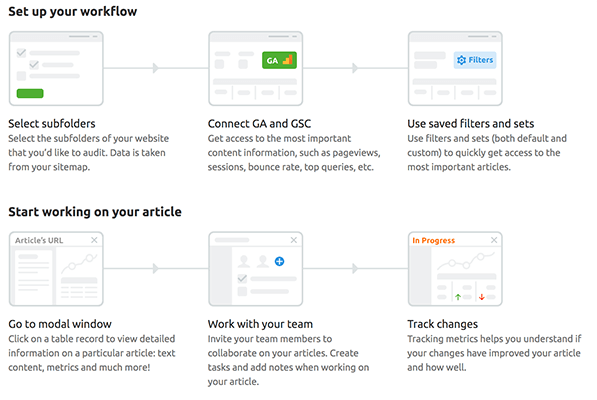
You can customize data sets. For example, articles that have a bounce rate or backlinks between a certain range.
Semrush will then display your content alongside data from your Google Analytics account. This makes it easy to see which content has flatlined.
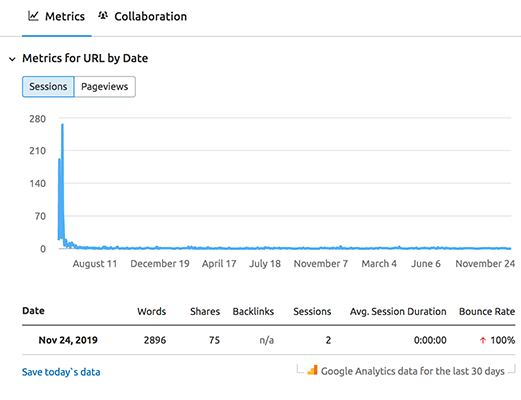
Like any tool, it’s not 100% perfect and you’d still need to check articles for anything that’s broken, and make changes to your content. But, it’s a huge time saver.
Take their free trial for a spin and see what you think.
5. Create your first digital product
Selling digital products is one of the best ways to make money as a blogger.
Unlike selling physical products, you don’t have to shell out cash buying inventory and delivery is handled digitally.
Your digital product can be as simple or as complex as you’d like it to be.
You could:
- Bundle blog posts together – The quickest option but they have the lowest perceived value. Still, they’d be well suited for Amazon Kindle.
- Write an ebook from scratch – Ebooks can be time consuming to create, but some bloggers do extremely well from book sales. Sell them via your website and/or platforms like Amazon Kindle.
- Create a course – There’s more of a learning curve in the selling of a course but they offer extremely high perceived value. In some cases, they can be faster to create than ebooks but upfront costs are higher due to purchasing video gear.
- Bundle products into a membership offering – Sell your products (courses/ebooks) as part of a membership site with a monthly fee. This offers the highest perceived value and a recurring income, but you’d need to deliver new content each month.
You could do one of these or all of them (eventually) – the important part is considering how all of your products fit together.
One option is to create smaller products first to build up a library of content, then leverage that library of content to build a membership website.
You will need a tool to handle the selling and delivery of your products.
Podia is a popular option because it allows you to sell courses, digital downloads and memberships. They do not take transaction fees like some other platforms.

They also offer live chat, digital storefronts and affiliate management. The latter is extremely useful because you can recruit other bloggers to sell your product and get a commission.
If you just wanted to sell digital downloads, SendOwl can work out cheaper. Although, it depends on your needs.
Now, creating a digital product is just one monetization strategy of many. We’ll cover other ways to monetize your blog later in this post.
6. Set up email automation to sell products and promote content while you sleep
Chances are that you’re already building an email list.
Most email marketing tools offer automation of some kind. Are you using it to grow your blog (and your business)?
The most common use of automation is to send out a series of emails in sequence using time-based intervals. This is often referred to as a welcome series.
Regardless, just using this simple type of marketing automation can be incredibly effective directing subscribers to your paid products and/or blog posts.
Here’s an example from my ConvertKit account:
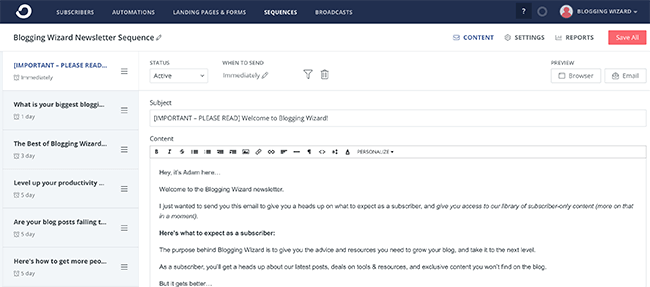
This sequence is then loaded as part of an automation sequence that performs a few other functions, such as tagging, etc.
What about more advanced uses of automation?
Yep, your automations can get pretty smart.
How? By offering a more personalized experience to your audience.
Instead of just sending out links to your content or helpful resources, you can apply tags to your subscribers when they click on each link.
Each of those tags could then trigger an email to be sent offering a product that is relevant to what they’ve just been reading, or add them to a new sequence that’s relevant to the topic of the post.
There are plenty of other ways you can use automation. From cart abandonment emails to referral marketing campaigns. Here’s a screenshot from ActiveCampaign’s automation library:
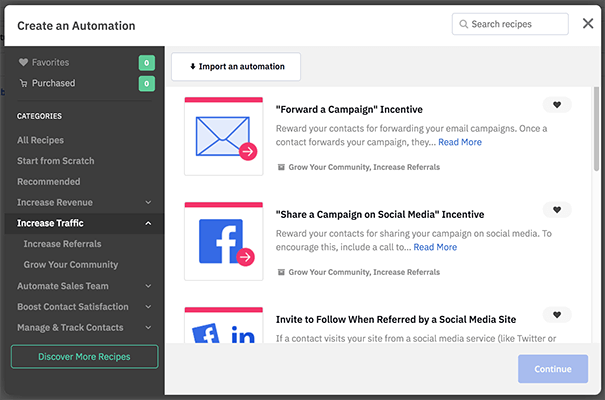
So, how can you use this to prepare your blog for the new year?
Plan out an automation sequence that enables you to add value to your audience, but also directs people to key products or content in a more personalized way.
Personalization is extremely effective at increasing conversions.
7. Take some time to learn more about your audience
The more you know about your audience, the better you can serve them.
Ultimately, this means you’ll grow your blog faster. And if you’re smart about monetization, you’ll be growing your income – not just your traffic.
So, what should you do to learn more about your audience?
Break down your ideal audience into several core groups and create profiles (or personas) of each one.
Making note of their challenges, demographics, needs, dreams, fears and anything else that helps you understand them.
You can gain some great insights from reading comments on other blogs in your niche, sifting through Quora answers, diving into Facebook Groups, and more.
But, one of the best ways to gain insights is to ask your audience by sending them a survey.
For example, I send out a link to a survey shortly after people sign up to my email list:
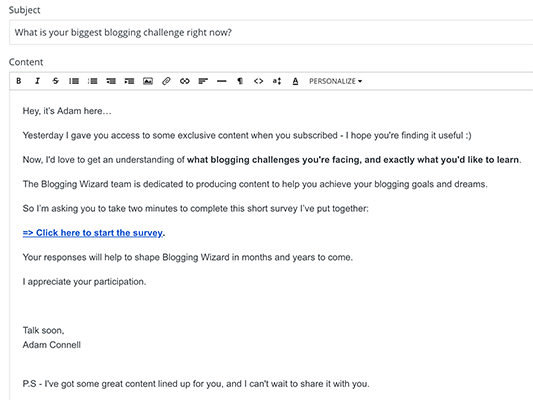
This helps me get to know my audience a bit better, provides feedback and an understanding of the type of content + topics people want.
I use the free version of Typeform.com to collect survey responses – it’s nice and easy.
Want to learn more about to create personas of your audience? Read this article.
8. Create landing pages for each of your lead magnets
Lead magnets are one of the best ways to build an email list, but could you be missing out on one of the biggest opportunities to get subscribers?
Here’s what I mean:
Most people will create a lead magnet and add a few opt-in forms to key locations of their blog – then call it a day.
There’s nothing wrong with that. It’s important to do – your blog is one of your best assets for building an email list.
But, the step that most people miss is creating dedicated landing pages for each lead magnet.
And to be clear, when I say landing pages, I mean a conversion-focused landing page that is free from distractions – not just a regular blog page with a sidebar.
Regular pages are horrible for conversions. Conversion-focused landing pages are where it’s at.
Here’s an example of one I use for my VIP resource library:
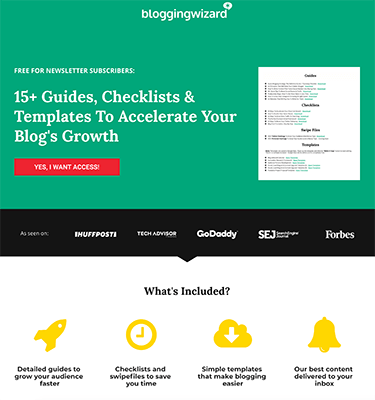
I used Leadpages to create this landing page by tweaking an existing template. It’s not fully optimized yet and hasn’t been split-tested. But it converts at around 30% which is pretty good.
When most opt-in forms on a blog convert below 1%, it’s easy to see why landing pages are so important.
Now, that’s one landing page but I have 15+ lead magnets. And you may have a bunch of them yourself.
…. That’s an opportunity, right there!
So, I created a dedicated landing page for one of our recent articles on Pinterest hashtags.
I duplicated the page, swapped out the hero image and tweaked the copy.

Then, I had my designer create a few different Pinterest images. Shared them to a few Pinterest boards and here’s what happened:
I got around 10 new subscribers within the first 30 minutes.
They weren’t shared anywhere else and no paid traffic was sent to the page.
Your mileage may vary, but regardless, I highly recommend using landing pages.
Even if social networks don’t perform well for you, there are plenty of other ways to promote landing pages.
This includes paid traffic such as Facebook Ads, your about page, your website navigation, footer area, and YouTube videos.
So, how do you create your landing page?
While there are plenty of best practices for landing page optimization, you’re going to need the right tool to help you.
Some email platforms like ConvertKit offer landing page creation, but it’s not that easy to work with which is why I prefer dedicated platforms.
I use Leadpages for most landing pages because it’s easy to use and offers all the features I need. Split-testing, plenty of templates, a flexible drag & drop editor, etc.
That said, this won’t be the right choice for everyone. To find a suitable tool, I recommend checking out my article on landing page software.
9. Learn a new skill to increase your earning potential
Is there a new skill you’ve been wanting to learn this year?
If you’ve struggled to find the time while juggling the day-to-day management of your blog, the new year is the perfect time to knuckle down and get into learning mode.
Every skill you learn and add to your arsenal makes you more valuable. Whether you’re adding value to your own business, or you’re adding value to somebody else’s.
So, what could you learn about? There are plenty of options:
- Copywriting
- SEO
- Email marketing
- Social media strategy
- Content strategy
- Web design
The key is to take what you learn and put it into practice on your own blog. Experience is essential.
Once you’ve built up your experience, you could leverage these skills to offer services to other businesses.
This is extremely useful if you’re in a position where you’re not earning money from your blog yet, or your income isn’t where you’d like it to be.
Here’s why:
Freelancing is the fastest way to earn money as a blogger. I’ve seen writers hit full-time income within 2 months by freelancing.
And you don’t have to take the freelance route. Some folks do well by scaling their freelancing work into an agency which allows them to free up more of their time.
10. Set up social listening for your brand and competitors
Big brands use social listening tools to monitor the web for mentions of their website, products, and their brand name.
Why? It allows them to find growth opportunities, support customers, and fix PR issues before they have a negative impact.
If you haven’t started your blog yet, or you’ve been blogging for a few months – you won’t get much mileage out of just yet.
But, if you’ve been blogging for a while now, or you’re using a blog to grow your business – it’s worth setting up social listening to monitor for mentions of your brand name, at the very least.
Here’s the good news:
It’s easy with the right tool. Just set up a few alerts for your domain, brand name, personal name, and main competitors.
Then, make sure you’re getting email notifications and you’re good to go. The tool will do all the heavy lifting.
But which social media listening tool should you choose?
The right tool depends on your needs and budget.
Here are a few solid options:
- Brand24 ($) – Purpose built for social media monitoring, Brand24 allows you to monitor the web and social media platforms for mentions. Create custom alerts, set-up email notifications, and more.
- Semrush ($) – A great all-round marketing platform that offers a deep feature set spanning SEO, content marketing and social media. You can also use it to monitor brand mentions on the web. Social media tracking is available but only for specific profiles (e.g. your profiles or competitors profiles).
- Google Alerts (Free) – This tool uses Google Search to monitor the web for mentions as they come into Google’s index. While it is free, it’s rather limited and misses most mentions picked up by other tools on this list.
What else can you do with social listening?
You can get pretty creative with social listening:
One of my clients ran a passport agency. He used social listening to find people in need of an express passport and generated a significant amount of revenue from Twitter using keyword and hashtag searches.
You can also use social listening to find mentions of your brand on other blogs. If they didn’t link to your blog, you can reach out and ask them to include a link.
Some of the best guest blogging opportunities can be found by setting up custom searches in a social listening tool.
And, one of my favourite uses is to find posts where I’m mentioned (or my blog is) – I like to comment on these posts to thank the author, and sometimes I’ll share them with my audience.
11. Plan a social media giveaway for the new year
Giveaways can generate a lot of engagement on social media and they typically require very little time to prepare.
Simply offer up a prize, use a contest tool to allow people to enter and set your entry criteria (e.g. follow on Twitter = 1 entry, join newsletter = 2 entries).
The result? You gain a bunch of followers (or email subscribers) as a result, and you make a bunch of your readers VERY happy.
Here’s a recent example from Elegant Themes:

And, I’ve had great results using giveaways for clients in the past.
So, what’s the first step to a successful giveaway?
The prize is the most important part but you also should consider:
- Relevance to your audience – Prizes that are more relevant will attract your target audience. Generic prizes (e.g. iMac/iPad) will attract a generic audience but likely increase the reach of your giveaway.
- Prize value – the more valuable, the better.
- Prize popularity – If the prize isn’t something people will want
- Number of prizes – More chances to win can encourage more people to take part.
You might be thinking:
“Ok, this is great but I don’t want to pay for something awesome to give away.”
And I hear you. You don’t need to spend anything.
Here’s how:
Reach out to brands in your niche and invite them to partner up on the giveaway.
If you have existing relationships with brands, leverage those relationships to secure prizes.
The giveaway will benefit the brand by providing them with increased visibility from simply taking part, and you can set additional entry methods to give them social media followers.
Tools to run your giveaway
There are plenty of giveaway apps and tools you could use. There are even dedicated WordPress contest plugins.
But my favorite give away tool overall has to be SweepWidget (read my review).
Why?
SweepWidget offers the best balance of features and affordability. In fact, it has a free plan that you can get a lot of mileage out of. And paid plans are extremely affordable – especially compared to other tools.
12. Take your branding to the next level with a fresh logo
If you tinker with your branding on a regular basis like I do – you may want to give this one a miss.
But, if your branding is lacking or hasn’t changed in a long time – the holidays are a great time for a refresh.
Here’s what you need to know about logos:
Either have a good logo or don’t have one at all – just use straight-up text instead.
Low quality or badly designed logos are one of the biggest credibility killers for websites.
First impressions are made within a split-second.
And, when someone clocks their eyes on a bad logo, it’s going to cause them to doubt the credibility of the rest of the site.
Ok, sure, design is pretty subjective but I think we can all agree that a logo designed in MS Paint using 90s style clipart is not the way to go.
If you’ve got a great eye for design – you could easily create something using a free design tool like Canva.
But, if you’re like me and graphic design is an alien concept to you – it’s best to hire a professional.
Here are some options for finding a logo designer:
- Obus – This is the guy who designs all of my logos. To date, I’ve hired him to design 15+ logos; including Blogging Wizard, Startup Bonsai, etc. He’s expensive compared to other Fiverr designers but he does great work. Unlike a lot of Fiverr designers, he creates custom icons and designs logos from scratch based on your needs.
- 99designs – You can choose from a wide range of skilled designers, or run a contest and choose the best logo.
Now, I did mention that I use a designer from Fiverr for my logos but getting decent quality design work from Fiverr is challenging. I tried other designers a few times when Obus was unavailable and the work was low quality.
While the idea low priced logos may seem alluring, it’s not worth it. Your logo is a core part of your brand identity and it’s worth paying a bit more to get the job done right.
13. Plan out your content for the next 12 months
You may have some content ideas lined up already. But, content plans work best when you plan them out over 12 months.
The holidays are a great time to get your content plan ready for the new year.
Sure, you may want to switch posts around or tinker with the plan as you go, but having some sort of plan makes it easier to stay focused.
You don’t need any expensive tools for this and you can create an editorial calendar easily with Google Sheets.
Here’s how to source topics you can write about:
- Keyword research – If you want Google to send you long-term traffic, use keyword research to find some of your topic ideas. Covering topics your audience is searching for is critical for blog growth.
- Quora – Q&A sites like Quora are a goldmine for topic ideas. Simply search for your niche or a related topic and you’ll get a load of specific questions you can directly answer with your content.
- Social media communities – Communities such as Reddit and Facebook Groups can offer deep insight into what questions your target audience has.
- Ask your readers – earlier in the post, I mentioned how you can include a survey in your automation sequence for new subscribers. Alternatively, you could send a broadcast to your list with a link to your survey, or share it on social media.
Once you know what to write about, you can consider how you’re going to frame your content.
You’ll need to choose a variety of blog post types:
- How-to’s
- Tutorials
- Listicles
- Reviews
- Opinion posts
- Interviews
- Personal stories
You could take things a step further by repurposing these blog posts for different audiences by turning them into different content types.
This approach will extend your blog’s reach and ensure you squeeze everything you can from the content you create.
Here are a few content types to consider:
- Infographics – Highly shareable and great for earning backlinks.
- Video – Allows you to tap into the built-in audience of platforms like YouTube.
- Audio – You could simply turn your existing content into audio using an automated service or use it as the topic for a podcast on iTunes, etc.
- Slideshare presentation – Slideshare is owned by LinkedIn and has a huge built-in audience.
When putting together your content plan, also consider:
- Your goals and logical next steps for readers – While your content needs to serve your readers, it also has to serve your goals (e.g. selling a course). You’ll get the best results when the next logical step for readers to take is aligned with your goals. For example, purchasing a Keto recipe book would be a logical next step for anyone reading an article about the benefits of the Keto diet.
- Consider grouping content together into themed months – This is more commonly used by journalists, specifically in niche magazines (e.g. Guitarist Magazine), and it can work nicely for bloggers as well. Learn more in our article on content themes.
And don’t forget, you’ll need to create a plan for your social media content tool. These social calendar tools will help.
14. Stockpile content ready for the new year
Want to come out of the gates swinging when the 1st of January rocks up?
You’re going to need some high-impact content ready go publish.
Since December is such a slow time of the year, I usually stop publishing content and focus most of my time on this single task – content creation.
The best part? In January and February I usually have twice as much time to devote to marketing my business and my content.
Try doing the same – it’s such a satisfying feeling to take time off over the holiday’s knowing the first few months of content is already scheduled.
Maybe you’ll split that extra time between content promotion and product creation, or another task on this list (remember: all of these tasks can be done at anytime in the year.)
So, get some content written up, and schedule it for publication in the new year. The more, the better.
15. Put systems in place to support the growth of your blog
As bloggers, we have to wear many different hats.
One moment we’re a social media manager. The next, we’re a content writer, SEO, content promoter, editor, or something else. The list goes on.
Now, let me ask you this:
Do you have a documented process for each of these tasks?
If not, it’s well worth doing.
Processes help us to save time, maintain focus and give us the ability to scale.
A good example is blog post promotion. I have a checklist that I run through whenever I publish a new post. Well, it’s more of an editing/promo hybrid checklist so it includes everything I need to do before and after publishing a post.
And here’s the thing:
Not everyone’s process will be the same. It’s critical to identify what’s important to you and your blog.
Specifically where promotion is concerned, there will be certain promotional channels that will only be relevant to your niche.
Note: Speaking of blog post promotion, be sure to check out our definitive guide to help you get started. Use it to create a promotional checklist that you can work through whenever you publish new content.
16. Prepare for the next phase of your blog’s evolution
If you looked at Blogging Wizard in 2012, you’d notice that it was very different to how it looks now.
Not just from the perspective of the design, but also the topics I talk about and how I write. I cringe every time I read one of my older posts. And sometimes more recent ones (lol).
Sometimes it makes sense for us to pivot our blog’s in a slightly different direction; maybe we need to be more specific about who our ideal audience is, or maybe we need to adjust our content plan.
You can spend huge amounts of time planning your blog’s launch, but you’ll always learn more after you start your blog.
Not just about blogging and how to better serve your audience – you’ll learn more about yourself and how blogging fits into your lifestyle.
Which is why we should always keep our minds open to the possibility of changing things.
So be mindful of the direction you want to take your blog, and don’t be afraid to change your approach – it could make all the difference.
17. Orientate yourself and your blog with a foolproof plan
As bloggers, content is our bread and butter. As such, it’s easy to focus entirely on our content plan.
But there’s a limit to the scope of a content plan.
You need a top-level plan for your blog. It needs to be crystal clear so you know exactly where your blog is going.
Think of it like a business plan. And, if your goal is to earn a living from your blog – that’s exactly what you need.
The web is full of business plan templates but most would need a little rejigging to be suitable for blogging.
Regardless, it’s a valid exercise. Even the business plan I wrote for a recording studio complex at University got me thinking on an entirely different level about business.
Even if you don’t do a full plan for your blog, it would be helpful to cover off the first few sections of a typical business plan. For example:
- Executive summary – It sounds more complicated than it is. Ultimately, this comes down to understanding who you will serve, and how you will serve them.
- Mission statement – Identify your why. It’s the difference between a blog that thrives and a blog that fails to reach its potential.
- Business objectives – Identify the single most important metric (e.g. gross profit), then give yourself a specific amount of revenue and a time frame to reach it by. You may want to highlight other objectives which is fine, but it helps to have a single north-star metric.
- Market research – We’ve already talked about audience personas which are a big part of this. Work towards understanding your niche, and the people in it.
- Competitor research – Competition is different for bloggers than it is for businesses and it’s important to remember that. In many cases, where traditional businesses would see competition, we may find an opportunity to grow together.
- Revenue channels – Most business plans specifically look at products or services here, but revenue channels for bloggers can be more diverse. This section should cover your income streams, risk factors, what sets your offering apart from others, etc.
- Marketing plan – Here, you’d look at exactly what you can do to market your blog. Your content plan would be part of a wider marketing plan. Most importantly, consider which marketing channels (e.g. email marketing + social media marketing) will help you achieve your goals in the most efficient way possible.
There are other parts to a traditional business plan, but these are the most relevant for bloggers, and should be enough for you to work through.
What if you have a plan already? Now is a good time to sit down and evaluate how well it’s going, and what you can do to take your blog’s growth to the next level.
So, go through all of the analytics you have for your blog (website traffic, email, social, etc.) and see what’s working – and what isn’t. From there, you can adjust your plan accordingly.
How will you prepare for a new year of blogging?
There are plenty of ways you can prepare for a new year of blogging – we’ve discussed a lot of them above.
But it’s important to note that this isn’t a checklist to work through – it’s a list of prompts. So, pick a few ideas and focus your time on those.
You can always bookmark this post and come back to it later in the year. All of these tasks are worth doing at some point.
I hope you’ve found this useful – now, go out there and get your blog ready. And most importantly, make sure you take some time out over the holiday to unplug and unwind.
Have a great new year!
Disclosure: Our content is reader-supported. If you click on certain links we may make a commission.

